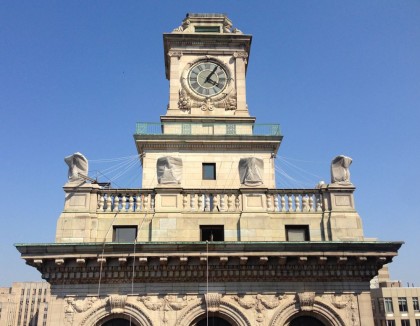In the News: Victory for Clocktower Access
 ••• “A five-judge panel upheld a March 2016 decision that prevented developers Peebles Corporation and Elad Group from converting the unique clock tower at 346 Broadway into a residential condominium, as part of a larger plan to renovate the former office building into 151 luxury condos. […] A group of local historic preservation organizations—including Tribeca Trust, Save America’s Clocks and the Historic Districts Council—sued Peebles and the city in June 2015 in Manhattan Supreme Court in an effort to block the conversion of the clock tower suite. The city’s Landmarks Preservation Commission issued a certificate of appropriateness in May 2015 that allowed the developers to renovate the clock tower, electrify its mechanism and turn it into a condo, which wouldn’t be accessible to the public. The local activist groups filed suit a couple months later and ultimately scored a victory in Manhattan state supreme court. […] However, the decision doesn’t spell out how often a historically protected space must open to the public. It could open once a month, once a year or once every couple years. The ambiguity means that an exact time frame for public access will probably be fought out in court at a later date, [attorney Frank] Chaney explained.” (Photo by Brett.) —Commercial Observer
••• “A five-judge panel upheld a March 2016 decision that prevented developers Peebles Corporation and Elad Group from converting the unique clock tower at 346 Broadway into a residential condominium, as part of a larger plan to renovate the former office building into 151 luxury condos. […] A group of local historic preservation organizations—including Tribeca Trust, Save America’s Clocks and the Historic Districts Council—sued Peebles and the city in June 2015 in Manhattan Supreme Court in an effort to block the conversion of the clock tower suite. The city’s Landmarks Preservation Commission issued a certificate of appropriateness in May 2015 that allowed the developers to renovate the clock tower, electrify its mechanism and turn it into a condo, which wouldn’t be accessible to the public. The local activist groups filed suit a couple months later and ultimately scored a victory in Manhattan state supreme court. […] However, the decision doesn’t spell out how often a historically protected space must open to the public. It could open once a month, once a year or once every couple years. The ambiguity means that an exact time frame for public access will probably be fought out in court at a later date, [attorney Frank] Chaney explained.” (Photo by Brett.) —Commercial Observer
••• At the Smyth hotel a couple of weeks ago, I noticed that the Raymond Pettibon artwork in the lobby was gone—in fact, the walls were generally barer. I asked a staffer, who said that the owner had removed the pieces that were part of his private collection. Now we know why: “Korman Communities bought the Smyth hotel in Tribeca for $72.2 million, records filed with the city Thursday show. Walton Street Capital was the seller and the original developer of the property in a joint venture with Tribeca Associates. […] Korman owns several other Manhattan hotels, including AKA Wall Street and AKA Central Park.” —Real Deal
••• Fashion designer Ji Oh, who lives in Tribeca, shares some of her neighborhood favorites. —Citiphile
••• “A city agency is shamelessly promoting a Downtown landlord’s scheme to redevelop public land for private profit, locals claim. The Department of City Planning, which was tasked with providing an impartial review of Rockrose Development’s application to convert arcade space at 200 Water St. into ground-floor retail and luxury apartments at an important hearing on Nov. 13, spoke of the plan in glowing terms while failing to mention any drawbacks to the hugely controversial proposal or the widespread public opposition, according to a member of Community Board 1. ‘There was no mention of the extraordinary amount of opposition,’ said Alice Blank, a Downtown resident and architect. ‘The Department of City Planning is working in lockstep with the applicant to push forward this application.'”
••• Some good letters on the vacant-storefront issue in the New York Times, including this one by small-business owner Frayda Levin:
Your editorial suggests several reasons for empty storefronts in New York City: rising rents, the growth of online shopping and the city’s onerous tax burden. But you don’t mention another obvious culprit: the set of labor laws and other mandates that the city has imposed. A partial list includes a city-supported minimum-wage mandate, a paid-sick-leave mandate, a recently passed employee scheduling mandate, labeling requirements and many more. Each time the city imposes these laws, business owners warn that these laws can harm businesses—mostly by raising costs above what shoppers can afford. Rarely does one law cause a business to go under. But the cumulative effect is a major reason there are so many empty storefronts. As the owner of a closed restaurant put it, “We do the numbers, and they don’t work anymore.” It is important to understand the devastating impact of these laws on otherwise viable businesses. Rolling them back is one way to enable entrepreneurs with very little in the bank to profitably run the businesses that once filled now-empty storefronts.












